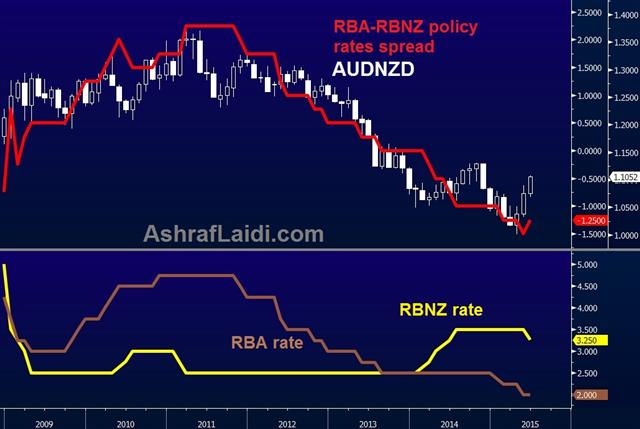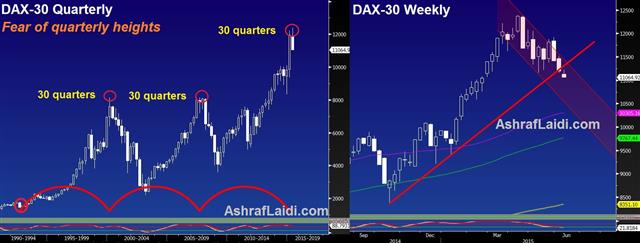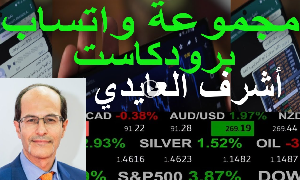Intraday Market Thoughts Archives
Displaying results for week of Jun 07, 2015RBNZ vs RBA
Last night's unexpected decision by the RBNZ to cut rates by 25 bps for the first time in four years triggered prolonged NZD losses mainly due to the clear message in the statement noting "…further easing may be appropriate” despite the 21% decline in the kiwi since last summer. The statement caused a shift in the market's thinking to anticipate a second RBNZ rate cut to occur as early as next month. The sharp easing patterns in Asia and throughout NZ's partners combined with the RBNZ's relatively lofty rates, bolsters augments the prospect for the central bank to reverse all of last year's 100-bp in rate hikes by early next year.
On the Aussie side, stronger than expected 42K jump in May employment and the plunge in the unemployment rate to a 12-month low at 6.0%, has sent the Aussie soaring across the board despite downward April revision. After the latest jobs figures and this week's speech from RBA governor Glenn Stevens, the RBA is no longer expected to cut interest rates this summer. That is especially the case when Australia's macroprudential policies have been slower to take off than in New Zealand. The charts below highlight there is further downside ground for RBNZ than for RBA rates, which correlates clearly between the AUDNZD cross and the RBA-RBNZ spread. Last night's Premium Insights trade in AUDNZD charts a particular path, considering semblance of stabilisation on the price front in China and improving dynamics in copper.

| Act | Exp | Prev | GMT |
|---|---|---|---|
| Employment Change (MAY) | |||
| 42K | 15.0K | -13.7K | Jun 11 1:30 |
| Full Time Employment Change (MAY) | |||
| 14.7K | -23.9K | Jun 11 1:30 | |
| Unemployment Rate (MAY) | |||
| 6% | 6.2% | 6.1% | Jun 11 1:30 |
| Part Time Employment Change (MAY) | |||
| 27.3K | 10.3K | Jun 11 1:30 | |
Wild Ride Continues, RBNZ, AUD Jobs Next
The smoke signals surrounding a Greek deal are getting thicker but the continued bond selloff and exceptional volatility remain the top stories. The yen roared in Asian trading after a quip from Kuroda while the US dollar and Swiss franc lagged on risk appetite. The RBNZ decision and Australian jobs are due later. Each of the Premium longs in EURUSD and GBPUSD are +210 pips, while the EURCAD long is +50 pips and all in progress.
Markets played a game of Deal or No Deal on Greece. The signs are increasingly positive as Dijsselbloem said only a few issues remain to be solved. Bloomberg had a story about Greece offering one concession 'up front' in return for aid while AFP suggested the bailout would extend to March 2016.
At some point, euro traders just throw their hands up with Greece and wait for the smoke to clear. The pair was in a wicked chop Wednesday, making several round trips in the 1.1260 to 1.1350 range before finishing near the top.
Cable, for the third day, was bashed by wild swings, including a 70 pip drop when Carney didn't deliver a hawkish speech. He focused on regulation instead and cable sagged but – yet again – there were buyers waiting in the weeds and it finishes close to the highs.
USD/CAD fell for the fourth day, touching 1.2205 as oil prices climbed.
The RBNZ decision could send shockwaves through the kiwi and then it's onto the Australian jobs report at 0130 GMT. The consensus is for 15K new jobs in May after a 2.9K decline in April. Amidst all the volatility in US trading Wednesday, the Aussie and kiwi were relatively quiet but that will quickly change.
In the bigger picture, we continued to focus on Bund yields as they rose to 1.06% to the highest since Wednesday. But there were signs of exhaustion (or ECB buying) as they tailed back to 0.98% by the end of the day.
مقابلتي اليوم مع سي ان بي سي العربية
أشرف العايدي على قناة سي ان بي سي العربية العربية - 10 يونيو المقابلة الكاملة 2015

Waiting on the Oil Glut
Crude prices rose $2 on Tuesday despite a US report detailing the oversupply in the oil market. The Canadian dollar was the beneficiary and led the market while the Swiss franc lagged. Elsewhere , the US dollar disappointment continued despite an upbeat JOLTS report. Also of interest is a speech by RBA'S Stevens at 02:50 GMT. Monday's Premium GBP is +30 pips in the green ahead of Wednesday's UK industrial production and the key speech from Carney. Friday's Premium EURUSD long is +150 pips in the green.
Chatter about the oil market has died off and OPEC failed to deliver any surprises. WTI prices have now been locked in a $58-$62 range for six weeks. Rest assured that it's not the end of the big moves in crude.
The same-kind of sideways dynamic followed the big move in USD/JPY. Once the market got complacent, the leg took place. In the meantime, we keep a close eye on the range and the news.
On the later front, the US Energy Information Administration spelled out the bearish fundamental picture. The EIA said oil output has been more resilient to lower prices than expected. They lowered 2016 prices forecasts, boosted 2015 US output forecasts by 2.6% and forecast rising US output in H2 2016.
Eventually, those dynamics will lead to renewed selling in oil (and CAD). Technically, however, oil continues to reject the lower end of its recent range and the most-recent low was higher than the late-May low. On the seasonal front, June is the best month for oil so sellers may need some patience.
Late on Tuesday, weekly API inventories also showed a 6.7m barrel drawdown in US supplies; much larger than 1.3m forecast for the EIA stockpile data. That sent crude prices another 60-cents higher.
In the broader market, Ashraf highlighted the dominant dynamics of the Bund-Treasury spread and that's where the focus remains. The US dollar was lackluster in NY trading, giving back earlier gains even as JOLTS job openings surged to 5376K from 5030K.
Up later, the focus in on Japan at 2350 GMT with April machine tool orders and PPI. At 0100 GMT, the BOJ's Sato speaks.
| Act | Exp | Prev | GMT |
|---|---|---|---|
| JOLTS Job Openings | |||
| 5.38M | 5.03M | 5.11M | Jun 09 14:00 |
| Industrial Production (APR) (m/m) | |||
| 0.5% | Jun 10 8:30 | ||
| Industrial Production (APR) (y/y) | |||
| 0.7% | Jun 10 8:30 | ||
USD's New Path of Least Resistance
The plot thickens for USD bulls as the US currency falls victim to a deepening in the dynamics, which had previously capped its advances, namely faster gains in German yields relative to the US, prolonged erosion in Germany's DAX and the resulting close of euro hedges and lack of continuity in Fed tightening its planned rate lift-off (assuming one will take place this year). Last week we mentioned the German-US 10year yield spread broke hit 4-month highs. Today, the downchannel in the spread sustained a key breakdown, which could potentially extend towards the -133 bps resistance.
The implications of the recovering German-US spread on the USD index are important considering that EURUSD accounts for nearly 2/3 of the basket in the index. The series of lower-highs in USDX and the break below the 96 support spells further downside towards 93.00.
As German yields and Eurozone inflation pick back up, the effect of any expected Fed tightening no longer rewards the USD as was the case three or four months ago, when Eurozone inflation was below zero and the ECB was desperate to buy every asset in sight a la SNB.
Finally, unlike in previous Fed tightening cycles, the upcoming rate hike (if it ever materializes) is not at all expected to be succeeded by further subsequent moves, which will only make the first rate hike a classic sell-the-fact. That is why, the USD's path of least resistance has been aggressive selling of rallies.

Fresh Squeezed Dollar Juice
The inability of the US dollar to continue higher on Monday shows cracks in the core of the US dollar rally. The euro led the way in a broad USD decline that squeezed out all the post-NFP gains. Up next it's Chinese CPI. Ashraf issued a new Premium trade in GBP a few hours ago. Friday's Premium long in EURUSD at 1.1110 is now yielding +170 pips and remains in progress.
Dollar bulls piled back in Friday after a strong non-farm payrolls report but the most-important trend at the moment is the slump in Bunds. That has spilled over to the DAX and euro, as Ashraf highlighted earlier. The way the euro reasserted itself so quickly on Monday highlights the dominance of the bund market at the moment.
The ECB's Noyer was asked about rising yields on Monday and although he didn't raise any alarm bells, he offered an explanation. He said that asset managers wrongly believed there may be a shortage of QE assets at the outset of the program and rushed into buying them. Those fears haven't borne out and now it's a rush to the exits. He also talked about the other reason for euro strength – economic performance. He said growth this year has been at the top end of what was expected. Questions and speculation about the ECB extending QE beyond Sept 2016 are dormant for the moment.
The main euro risk is Greece but despite frequent bouts of thunder and lighting, officials appear to be inching towards a compromise. More broadly, it appears the US dollar may need more than good economic news to reignite the rally. Given the painful moves on Monday, more dollar buyers could soon head for the sidelines.
But first, the focus shifts to China with CPI numbers at 0130 GMT. The market expects just 1.3% y/y inflation with a flat m/m reading. China took small steps to stimulate some housing markets yesterday and a low print could mean a boost for the boarder economy.
Also, keep a close eye on the Australian dollar as traders there return from a holiday and lower-tier indicators on job ads, housing finance and business confidence are released.
| Act | Exp | Prev | GMT |
|---|---|---|---|
| Consumer Prce Index (MAY) (m/m) | |||
| 0.0% | -0.2% | Jun 09 1:30 | |
| Consumer Prce Index (MAY) (y/y) | |||
| 1.3% | 1.5% | Jun 09 1:30 | |
| NAB's Business Confidence (MAY) | |||
| 3 | Jun 09 1:30 | ||
30-quarter cycle in DAX-30 strikes again
Germany's DAX-30 index could no longer keep up appearances, as the formation of lower-highs became evident to the least suspecting of technical analysts. Hitting 4-month lows today, the index has fallen11% from its April highs, but remains +13% YTD in euro terms and +5% in USD terms.
The 30-quarter cycle joining major peaks in the Dax highlight the dangers of prolonged downside ahead as higher yields risk becoming a secular trend and the euro is further supported by rising Eurozone inflation and a hesitant Fed.
The deepening inverse relationship between the Dax and EURUSD and the positive relation with German bund yields highlights the improvement in German and Eurozone figures, particularly the increasing reality that Eurozone inflation will break above 1.0% before end of Q3, well beyond the ECB's 0.3% forecast for 2015. My calls for 1.10% in 10-year bund yields and $1.1550 for EURUSD in recent weeks support decision to issue a long EURUSD at 1.1110 on Friday after the NFP, available for Premium Insights members to view alongside the 3 charts.

مقابلتي مع ندين هاني على قناة العربية
مقابلتي مع قناة العربية اليوم https://www.youtube.com/watch?v=eSxOkekE06g&feature=youtu.be

Greece Gets Testy, Yen Shorts Jump Again
Eurogroup President Jean-Claude Juncker sent the clearest message yet that Greek talks are deteriorating as he refused to take a weekend call from Tsipras. Up next, it's a round of economic data from Japan, including GDP revisions. CFTC positioning data showed a second consecutive jump in yen shorts.
On Sunday, Juncker took another stab at Tsipras saying “in order to remain friends one has to respect some minimum rules.” The turmoil could weigh on the euro at some point Monday but it's only down a handful of pips in early trading.
Up next, a busy round of economic data hits at 2350 GMT when Japan releases its final revisions to Q1 GDP. Early estimates were middling but revisions have been consistently higher and the final look is expected to boost the pace of growth to 2.8% from 2.4%. It's likely to be another dagger to those looking for more QE this year.
Current account, bank lending and trade balance numbers will be reported at the same time.
It's a holiday in Australia.
Commitments of Traders
Speculative net futures trader positions as of the close on Tuesday. Net short denoted by - long by +.
EUR -165K vs -172K prior
JPY -86K vs -62K prior
GBP -26K vs -26K prior
AUD -13K vs +6K prior
CAD -1K vs +4K prior
CHF +8K vs +8K prior
Just two weeks ago, the market was nearly neutral on the yen but the breakout in dollar has traders piling in. That helps to explain why the dips have been narrow and have been bought aggressively. No doubt the trade is even more crowded after non-farm payrolls.
Also note that CAD and AUD have flipped to short from long, but the market has done a middling job of staying on the right side of that trade.
| Act | Exp | Prev | GMT |
|---|---|---|---|
| GDP Annualized (Q1) | |||
| 2.4% | Jun 07 23:50 | ||
| GDP (Q1) (q/q) | |||
| 0.6% | Jun 07 23:50 | ||
| GDP Deflator (Q1) (y/y) | |||
| 3.4% | Jun 07 23:50 | ||
| Current Account n.s.a. (APR) | |||
| ¥2,795.3B | Jun 07 23:50 | ||
| Bank lending (MAY) (y/y) | |||
| 2.6% | Jun 07 23:50 | ||
| Trade Balance - BOP Basis (APR) | |||
| ¥671.4B | Jun 07 23:50 | ||







